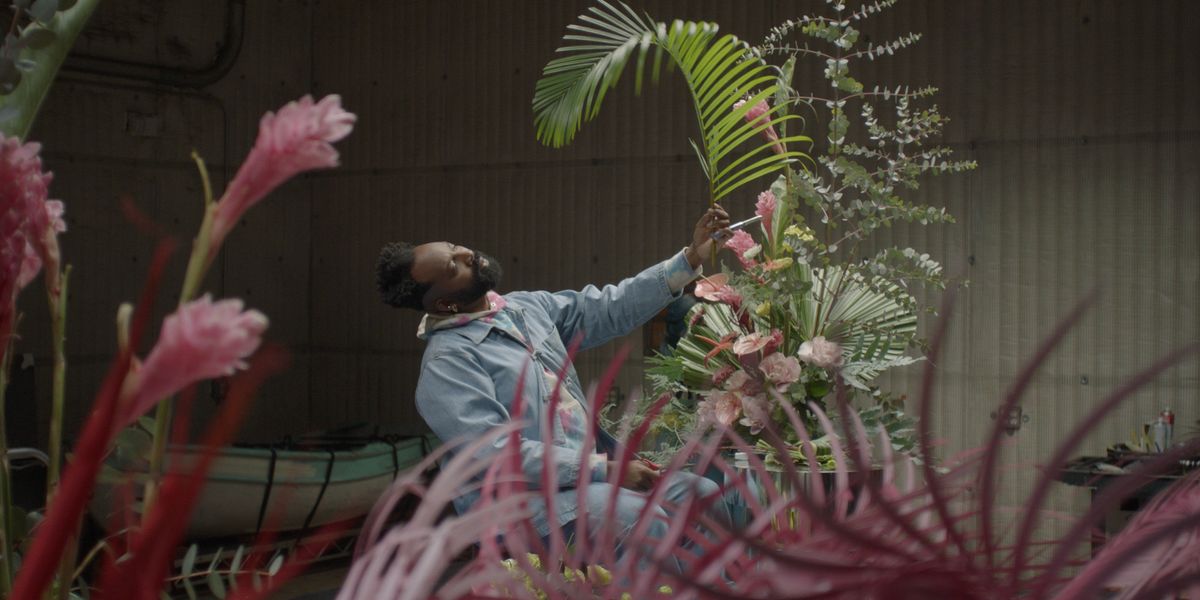Meet the Star of Quibi's Show Combining Floral Design With Dance
You may know Maurice Harris from his Bloom & Plume floral designs and recent Microsoft commercials, or maybe you frequent his Bloom & Plume coffee shop in Los Angeles. Most recently, Harris hosts “Centerpiece” on Quibi, and it’s hard to miss him dancing his way through the series.
Harris took his first dance class as a remedy for burnout. After creating countless elaborate window displays for Juicy Couture, Harris felt both creatively and physically depleted. A concerned friend invited Harris to come to a beginner’s dance class at Ryan Heffington’s The Sweat Spot, and, as he put it, “it felt like leaving it at the altar.” The way precision met effortlessness brought him back to his days as a drum major in high school.
Harris eventually started teaching his own classes and dancing and choreographing for commercials. “It is wild the amount of dance jobs that I have gotten,” he says. “Dance is a huge part of my story that I often don’t get a chance to talk about.”
Meanwhile, Harris pivoted professionally to floral design. “I’ve always had things that I do outside of my job to help fulfill my creativity because creativity when you exchange money is just not pure anymore,” he explains. Eventually his arrangements drew in clients such as Louis Vuitton, Goop, Dior, Nike and Gucci.
Friends from production companies Alldayeveryday and Le Train Train insisted Harris should host his own series. Harris posits, “It’s got to be about magic. It’s got to be about love. It’s going to be about light. It’s got to be about flowers, but not basic.” After massaging the concept for a year, Quibi, the new streaming platform for mobile content, understood the show’s value and greenlit the series.
Combining flowers with drumline, contemporary, ballet and hip hop all in one series, dancing through show transitions and performing with guests such as Rashida Jones allows Harris to remain fluid within a framework. First and foremost, “I really have to feel the music.” At the same time, “I understand my body and the limits of my movements,” Harris says. “I have bad knees, but I know that I have long, beautiful arms, so I’m able to use that extension.”
Between flowers and dance, Harris is clearly attracted to ephemeral art forms. “I think flowers and movement are the most beautiful reminder to be present because you cannot capture it, but you can experience it,” he says. Fleeting mediums challenge a society with “crazy control issues” and demands viewers to “question your own attachment issues.”
Dance informs Harris’ floral compositions, as well. A client observed that Harris’ arrangements “look like dancers moving” because his designs make the eye move.
Above all else, Harris created “Centerpiece” to move the racial inequality conversation forward. “White people who have been at the forefront of controlling the narrative for so long are now being held accountable for the lack of inclusion.”
Black dance companies influenced Harris. For instance, watching Alvin Ailey “was the first time that I was able to see Black excellence in a way that informed my creative process and formed the way that I set up my businesses.” Harris argues “there’s a grace, a power and an elegance that I see when I see dance on Black bodies.” We need “to reconcile that we put certain mediums and identities at the top of the food chain.”
Harris’ movement carries the weight of justice and bears witness to Black genius and joy. “I am always moving. If I’m not dancing, I’m singing. If I’m not singing, I’m throwing shade.”




